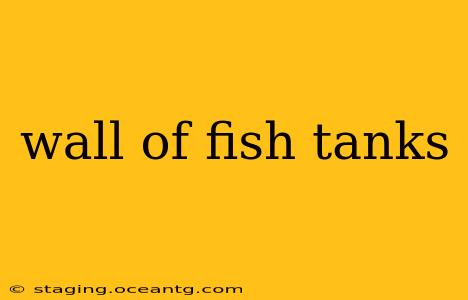A wall of fish tanks is a breathtaking centerpiece, transforming any room into an underwater paradise. This isn't just about aesthetics; it's about creating a captivating ecosystem that demands careful planning and execution. This guide will walk you through the process, from initial design to ongoing maintenance, ensuring your aquatic wall becomes a source of pride and relaxation.
What are the benefits of a wall of fish tanks?
A wall of fish tanks offers a plethora of benefits beyond the visual appeal. It creates a calming, meditative atmosphere, bringing the serenity of the ocean into your home. Furthermore, it can significantly increase the value of your property, acting as a unique and impressive architectural feature. The sheer scale of such an installation often becomes a conversation starter, leaving a lasting impression on guests.
How much does a wall of fish tank installation cost?
The cost of a wall of fish tanks varies dramatically based on several factors: the number and size of tanks, the type of materials used (glass, acrylic, custom framing), the complexity of the plumbing and filtration systems, and the labor costs involved. A small, simple installation might cost a few thousand dollars, while a large, elaborate system could easily reach tens of thousands or even more. Getting multiple quotes from experienced aquarium installers is crucial to understanding the overall expense.
How do I design a wall of fish tanks?
Designing your aquatic wall requires careful consideration of several elements:
- Space: Measure the available wall space precisely. Consider the weight the wall will need to support, as multiple, large tanks are incredibly heavy. Structural reinforcement might be necessary.
- Tank Size and Number: Determine the number and size of tanks based on the available space and your budget. Smaller tanks are easier to manage but might not create the same impactful visual effect as larger ones.
- Tank Placement: Carefully plan the placement of individual tanks to optimize viewing angles and create a balanced aesthetic.
- Plumbing and Filtration: This is arguably the most critical aspect. A well-designed system ensures efficient water circulation and filtration across all tanks, minimizing maintenance and maximizing the health of your aquatic inhabitants.
- Lighting: Strategic lighting dramatically enhances the visual appeal, highlighting the fish and plants. Consider LED lighting for energy efficiency and color customization.
- Species Selection: Choosing compatible fish species is crucial for a thriving ecosystem. Research different species' requirements for water parameters, tank size, and social behavior. Avoid overcrowding.
What kind of filtration system do I need for multiple tanks?
A multi-tank system demands a robust filtration system capable of handling the combined water volume. Options include:
- Centralized Filtration: A single, powerful filter that circulates water through all tanks. This requires careful plumbing and is best suited for larger installations.
- Individual Filtration: Each tank has its own filter. This provides more control but might be less efficient and aesthetically less pleasing than a centralized system.
- Combination System: A blend of centralized and individual filtration to optimize both efficiency and individual tank control.
A professional aquarium installer can help design the optimal filtration system for your specific needs.
What are the maintenance requirements for a wall of fish tanks?
Maintaining a wall of fish tanks requires consistent effort. Tasks include:
- Regular Water Changes: Partial water changes are necessary to remove waste and maintain water quality.
- Filtration Maintenance: Cleaning or replacing filter media regularly prevents filter clogging and ensures optimal water filtration.
- Monitoring Water Parameters: Regularly test water parameters (pH, ammonia, nitrite, nitrate) to ensure they remain within the healthy range for your chosen species.
- Cleaning Algae: Algae growth is inevitable. Regular cleaning helps maintain the aesthetic appeal and ensures the health of your fish.
- Fish Health Monitoring: Regularly observe your fish for signs of illness or stress.
Can I build a wall of fish tanks myself?
While technically possible, building a wall of fish tanks is a complex undertaking. Unless you have extensive experience in plumbing, electrical work, and aquarium maintenance, it's strongly recommended to hire professional installers. Improper installation can lead to costly leaks, electrical hazards, and harm to your aquatic life.
Creating a wall of fish tanks is a significant investment, both financially and in terms of time and effort. However, the result is a stunning and rewarding feature that will bring joy and tranquility for years to come. Remember to plan carefully, seek professional advice, and be prepared for ongoing maintenance. The beauty and serenity of your underwater masterpiece will be well worth the investment.
